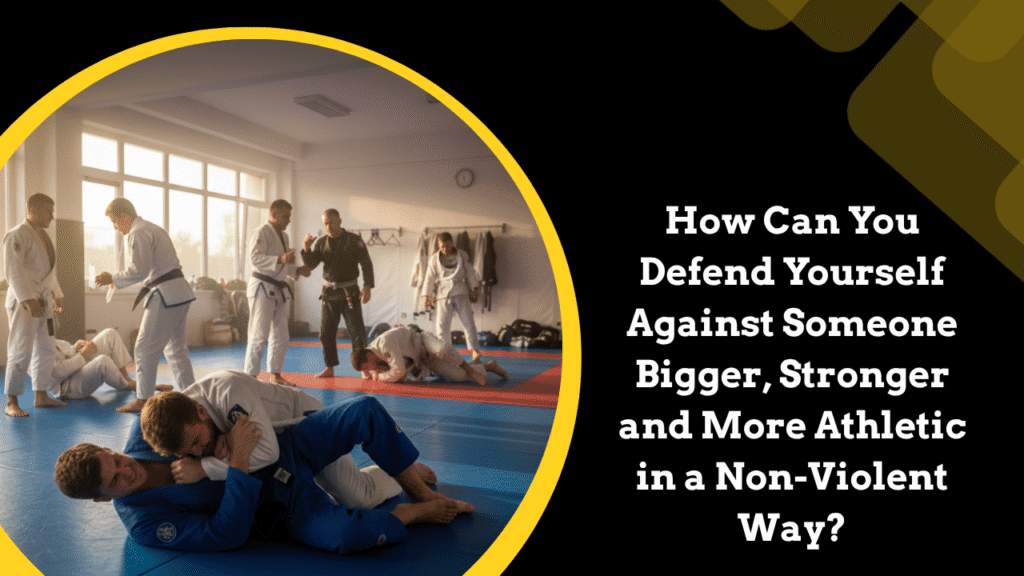
In real-life confrontations, size and strength often seem like unbeatable advantages. Many people believe that if an aggressor is taller, heavier, or more athletic, there is little they can do to defend themselves — especially without resorting to violence.
However, Brazilian Jiu-Jitsu (BJJ) was designed precisely to solve this problem. This martial art teaches that technique beats strength, and that you can stay safe, escape danger and control an attacker without striking, injuring, or escalating the situation.
Why Non-Violent Defense Matters
Most self-defense situations happen unexpectedly and often involve someone you know: a coworker, a classmate, a person at a bar, or someone in a stressful situation.
Striking or fighting back aggressively can make the situation worse, resulting in:
- Legal consequences
- Physical injury for both individuals
- Escalation into a more dangerous fight
A non-violent approach, like the one taught in Jiu-Jitsu, focuses on control, stabilization, and safe escape, not causing harm.
What Makes Brazilian Jiu-Jitsu Effective Against Larger Opponents?
1. Leverage Over Strength
BJJ teaches how to use:
- Body positioning
- Angles
- Leverage
- Momentum
These principles allow a smaller person to neutralize a stronger opponent. Techniques like guard, sweeps, and frames help create space and control without needing physical power.
2. Ground Control Eliminates Size Advantages
Most real-life altercations end up on the ground. BJJ specializes in ground fighting, where:
- Strength is less relevant
- Technique becomes the deciding factor
- You can immobilize someone without striking
This allows you to stay safe and avoid escalation.
3. Submissions for Control — Not Harm
In Jiu-Jitsu, submissions such as armlocks and chokes can control an aggressor without causing permanent damage. The goal is not to injure but to create a position where the attacker can no longer continue their aggression.
It is a controlled form of self-defense, not an act of violence.
4. Escapes and Evasion Are a Core Skill
BJJ teaches how to escape from the worst positions possible:
- Being pinned
- Being grabbed
- Being held down
- Being pushed or pulled
For self-defense, the priority is not to “win,” but to get out safely.
5. Staying Calm Under Pressure
Training Jiu-Jitsu develops:
- Emotional control
- Stress tolerance
- Clear thinking in chaotic situations
This mental discipline is crucial when facing someone bigger or more aggressive. Remaining calm reduces the risk of panic, fear-based reactions, or unnecessary violence.
Situations Where Jiu-Jitsu Provides a Non-Violent Solution
BJJ is extremely useful when:
- Someone grabs you
- You are pushed or taken to the ground
- A larger person tries to restrain you
- You need to control someone without hitting them
It gives you tools to protect yourself, control the situation, and de-escalate.
Why “Non-Violent Self-Defense” Is the Future
In a world where safety and responsibility matter, BJJ stands out because:
- It prevents injuries
- It avoids escalation
- It empowers anyone regardless of age, size or gender
- It prepares you for real-life scenarios, not just sport
You learn to defend yourself without becoming the aggressor.
Jiu-Jitsu Makes the Impossible Possible
Defending yourself against someone bigger and stronger may seem impossible — but with Jiu-Jitsu, it becomes achievable, safe, and non-violent.
When size and strength don’t matter, anyone can stay safe.
Are you interested in learning Jiu Jitsu? 👉 Visit graciejiujitsuwesthouston.com to schedule your class and start your journey today.
